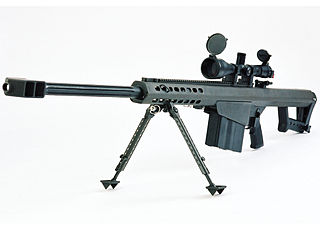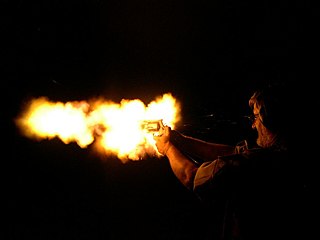
In firearm designs, the term single-shot refers to guns that can hold only a single round of ammunition inside and thus must be reloaded manually after every shot. Compared to multi-shot repeating firearms ("repeaters"), single-shot designs have no moving parts other than the trigger, hammer/firing pin or frizzen, and therefore do not need a sizable receiver behind the barrel to accommodate a moving action, making them far less complex and more robust than revolvers or magazine/belt-fed firearms, but also with much slower rates of fire.

John Moses Browning was an American firearm designer who developed many varieties of military and civilian firearms, cartridges, and gun mechanisms, many of which are still in use around the world. He made his first firearm at age 13 in his father's gun shop and was awarded the first of his 128 firearm patents on October 7, 1879, at the age of 24. He is regarded as one of the most successful firearms designers of the 19th and 20th centuries and a pioneer of modern repeating, semi-automatic, and automatic firearms.

The .50 BMG, also known as 12.7×99mm NATO, and designated as the 50 Browning by the C.I.P., is a .50 in (12.7 mm) caliber cartridge developed for the M2 Browning heavy machine gun in the late 1910s, entering official service in 1921. Under STANAG 4383, it is a standard service cartridge for NATO forces. The cartridge itself has been made in many variants: multiple generations of regular ball, tracer, armor-piercing (AP), incendiary, and saboted sub-caliber penetrator rounds. The rounds intended for machine guns are made into a continuous ammunition belt using metallic links.

An anti-materiel rifle (AMR) is a rifle designed for use against military equipment, structures, and other hardware (materiel) targets. Anti-materiel rifles are chambered in significantly larger calibers than conventional rifles and are employed to eliminate equipment such as engines and unarmored or lightly armored targets. Although not originally designed for use against human targets, the bullet weight and velocity of anti-materiel rifles gives them exceptional long-range capability even when compared with designated sniper rifles. Anti-materiel rifles are made in both bolt-action as well as semi-automatic designs.

The Barrett M82 is a recoil-operated, semi-automatic anti-materiel rifle developed by the Australian-owned company Barrett Firearms Manufacturing and produced in the United States.

A .50 caliber handgun is a handgun firing a bullet measuring approximately 0.5 inches (12.7 mm) in diameter intended with the task of penetration. Historically, many black powder pistols fired bullets with diameters well above a half inch. However, following the development of smokeless powder, the focus shifted to smaller-diameter bullets propelled at higher velocities, and the development of .50 and larger calibers in handguns became uncommon.

The ArmaLite AR-50 is a .50 BMG, single-shot, bolt-action anti-materiel rifle manufactured by ArmaLite.

The Steyr HS .50 and the Steyr HS .460 are single-shot anti-materiel rifles manufactured by Steyr Mannlicher and chambered in .50 BMG and .460 Steyr, respectively. Unlicensed variants of the HS. 50 include the AM-50 Sayyad produced by Iran, the Golan S-01 produced by Syria and the Al-Ghoul rifle produced by the Al-Qassam Brigades.

The Barrett M99 is a single-shot anti-materiel rifle that was first introduced in 1999 by the Barrett Firearms Company as a less expensive alternative to the company's higher-priced offerings. The rifle uses a bullpup configuration with a pistol grip. Its primary market was long-range competitive target shooters and in 2001, a shooter set a world record at 1,000 yd (910 m) with the M99 by shooting a 5-shot group which measured 4.09 in (10.4 cm).
The Gepárd anti-materiel rifles are a family of Hungarian weapons manufactured by Sero International Kft. designed to destroy unarmored and lightly armored targets. These long-range large-caliber rifles have high accuracy and muzzle velocity. In 1987, the Hungarian People's Army sought to obtain a compact, mobile weapon that could damage lightly armored targets. The project, led by Ferenc Földi, culminated in the creation of the Gepárds.
The McMillan TAC-50 is a long-range anti-materiel rifle. The TAC-50 is based on previous designs from McMillan, which first appeared during the late 1980s. From May 2017 until November 2023, it held the record for the longest confirmed sniper kill. McMillan produces several .50 caliber rifles, based on the same proprietary action, for military, law enforcement and civilian use. It is produced in Phoenix, Arizona, in the United States by McMillan Firearms.
The AS50 is a semi-automatic .50 BMG anti-materiel precision rifle manufactured by British firearms producer Accuracy International. It enables operators to engage targets at very long range with high accuracy using explosive or incendiary ammunition, and employs a gas operated semi-automatic action and muzzle brake, allowing for lower recoil than the AW50 bolt-action rifle and faster target acquisition. The rifle is highly transportable, ergonomic and lightweight. It can be disassembled in less than three minutes and serviced without tools.

Serbu Firearms is an American manufacturer of firearms based in Tampa, Florida, founded by mechanical engineer Mark Serbu.

The DSR-1 is a compact bolt-action sniper rifle designed, manufactured and marketed by the German company DSR-Precision GmbH and was also marketed by the German company AMP Technical Services as a specialized sniper rifle for police sharpshooters. It has been adopted by the German counter-terrorist unit GSG 9, as well as by other European special police units and agencies.
The Barrett M90 is a bolt-action, bullpup rifle chambered in .50 BMG. It was designed and manufactured by Barrett Firearms Company. In 1995, Barrett stopped production of the M90, and replaced it with the M95.

The Robar RC-50 is a bolt-action anti-materiel rifle chambered in .50 BMG manufactured by Robar Companies, Inc. The RC-50 is found in two variants—the original RC-50 and the side-folding buttstock RC-50F.
The DSR-Precision DSR-50 is a bullpup bolt-action anti-materiel rifle developed and manufactured by DSR-Precision GmbH and chambered in .50 BMG. It is essentially an upscaled DSR-1.
The Bushmaster BA50 is a bolt-action, magazine-fed rifle designed to shoot the .50 BMG cartridge. It has a 22- (carbine) or 30-inch, match grade Lothar Walther free-floating barrel with a 1-in-15-inch twist rate. The rifle weighs 30 pounds and has a muzzle brake to help tame the recoil. Bushmaster literature says that the rifle recoils like a .243 Winchester. The barrel has a MIL-STD-1913 rail for mounting a rifle scope.
Harris Gunworks, a Phoenix, Arizona based U.S. firearms manufacturer, began operations as G. McMillan & Co. after Gale McMillan spun off the rifle building portion of his McMillan Rifle Stock business. McMillan sold this to a group of investors headed by Wes Harris. With Harris as President, the company received its first of many military contract awards. Harris parlayed McMillan's reputation for high quality, high accuracy benchrest competition rifles, to create markets for military sniper rifles and custom hunting rifles.

The .950 JDJ (24.1×70mm) is an obsolete powerful large caliber rifle cartridge developed by American gunsmith and weapon designer J. D. Jones of SSK Industries.













